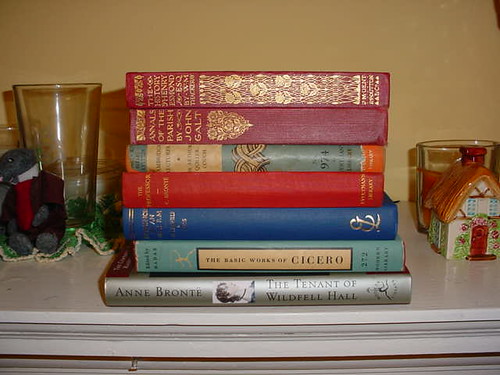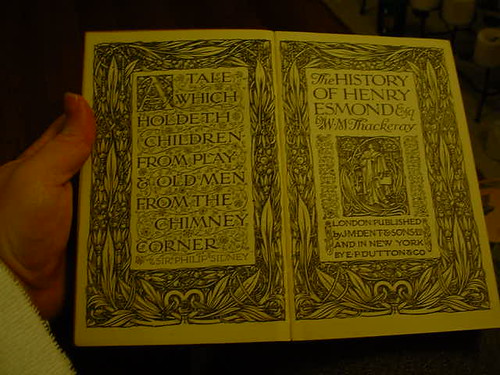I have to say I mostly agree.
One of the comments she makes is: "Elitism is only a bad thing if there are people to whom it is off limits. In America anyone can be as elite as they want to be."
So I'm going to riff on that a little, because oddly enough, I was going to talk about the idea of making works viewed today as something only the "elite" would read, open to all.
I mentioned the other day that the two books I bought were "Everyman's Library" sized books. Perhaps not everyone out there is familiar with this series of books but it's one I dearly love, both because of the concept behind it, and because of how the books were produced.
The original concept (Wikipedia article, for what it's worth) was developed by Dent publishers in Great Britain (partnering with Dutton over here), early in the 20th century. The idea was to have a "library" of about 1000 volumes, produced in such a way that they'd be generally affordable - affordable for students or for the working person. But nice enough that the upper classes might want them, too.
(I'm not going to comment on the usage of the word "-man" as part of the series title. I am merely going to assume that "Everyman" is the generic description for people. And more specifically, EVERY person...the concept of "everyman" as sort of the general average person. I don't want to see the word gender-neutralized. Because "Everyone's Library" sounds very Romper Room, and "Everyperson's Library" is ugly and clunky. I am sure there are those out there who would be offended by the use of "EveryMAN," but I choose not to be.)
Many of the books published (if the ones I've run across are any indication) were "classics" of some sort - either classic novels, or translations of ancient works, or books of intellectual essays, or things like Darwin's "Voyage of the HMS Beagle."
This article (recently published in a North Carolina paper; I'm not sure how long the link will stay good), gives a bit more of the history and a bit of almost-hagiography:
The Everyman's Library was more than paper and ink. It was a utopian project that put books at the center of human progress. In our own time, when literature has receded to the margins of popular culture, the Everyman's Library reminds us not too long ago millions of American and Brits believed that the books could make them better people....The Everyman's Library thrived because it reflected the aspirational culture that once flourished among those for whom higher education was beyond reach. Before radio, TV and the Internet changed our definition of culture and knowledge, many working-class people (itself now a quaint term) agreed with the 19th-century English writer Matthew Arnold that we could come "to know ourselves and the world" only by encountering "the best that has been thought and said."
So, as Lynn said: Elitism is only bad when there are people to whom it is closed off. Everyman's Library was an attempt to make that kind of learning, that kind of sophistication and appreciation, available to all.
The books - especially the early ones, which are apparently the ones featured in the exhibit at Chapel Hill - are extremely beautiful. The earliest (pre-WWI) ones had gilt-stamped spines and seemed to be heavily influenced by the Arts and Crafts Movement.
The books are also small - a small enough size to be slipped into a pocket (They are roughly the dimensions of a modern mass-market paperback, but of course a bit heavier). There is something pleasing about that size and shape - there is just something general that pleases me about the production values of the books. They are good objects.
I am lucky in that I own a few of these treasures. Everyman's Library went through a series of transformations over the years, becoming less ornate (probably to keep production costs down and to suit the more streamlined tastes of the time) but the ideals remained intact.
Here's a stack of books from my collection. (At the bottom are two "Modern Library" books, which seems to have been a similar experiment, done by a different publisher).

The top books are the oldest - I think the copyright date in the top book ("The History of Henry Esmond, Esq." in case it's too hard to read) is 1911. The one below it is slightly later, the next two are from the 30s, the blue-spined one is from just after WWII, the Cicero is a Modern Library from (I think) the 50s, and The Tenant of Wildfell Hall I bought perhaps 10 years ago, new.
(Sadly enough - I have not read any of these yet. I have dipped into the Cicero from time to time but that's it. The older books are not good read-in-bed books - where I do most of my reading these days - because if you fall asleep and drop them on the floor, you're prone to break the binding).
Speaking of Arts and Crafts influence, the "facing pages" (I don't remember specifically what they're called but they're the first real pages in the book) of the old Everyman's books are incredible:

I know this is a phrase I perhaps over use - but that is something that feeds my soul. It makes me so happy to open the book and see it there. To think that someone went to the time and the trouble to do that engraving, that the men producing the book felt it was important to have that thing of beauty there.
Sadly, outside of REALLY expensive books these days (like the Folio Press books that I buy), you don't see that kind of production going into something like a book. And that makes me a bit sad. It seems that "product design" these days is done as cheaply as possible, and so a lot of times, you get what are really rather ugly things (especially when you compare them with the "modding" that people who care about such things have done - when I look at the "steampunkified" PCs and compare them to the plain boxy functional flat black Dell that is in my office, it makes me a little sad, because I see how fun and stylish things COULD be. But they aren't. Oh, I suppose if they had to do all of that - old typewriter-key keyboards, fancy brass curlicues on the monitor frame - it would raise the price of the computer beyond what the average Joe could afford. But sometimes, in my daydreams, I wish I wouldn't - I wish things HAD a bit more style and flourish and prettiness and unnecessariness.)
And in a similar daydream, I imagine what our culture would be like if we were a nation of plumbers who read Shakespeare and officeworkers who kept a couple volumes of Thackeray in their bottom desk drawer for slack times at work. Where people would prefer to read about Ancient Greece rather than the exploits of the current messed-up celebutante du jour.
I don't know if our culture would be better, but it might be more interesting and unexpected.
2 comments:
I read a journal article about research into turn of the century "New Year's Resolutions." It turns out that most young women's resolutions were things like "read more Shakespeare," "be more considerate" and "pray more." The study reviewed current young women's resolutions and found more things like "lose five pounds" and "grow my nails." Perhaps if we were reading those "Everyman's Library" books, we'd be working on something besides personal appearance. Not that I'd mind losing five pounds, mind you, but I am working through Jane Austen once again as well as Charlotte Mason's "Home Education" series. Dessert? Dorothy Sayers' "Lord Peter Whimsey" short stories.
Beautiful! I've often wished that the people who make things still went to the trouble of making them beautiful. And thanks for the link.
Post a Comment